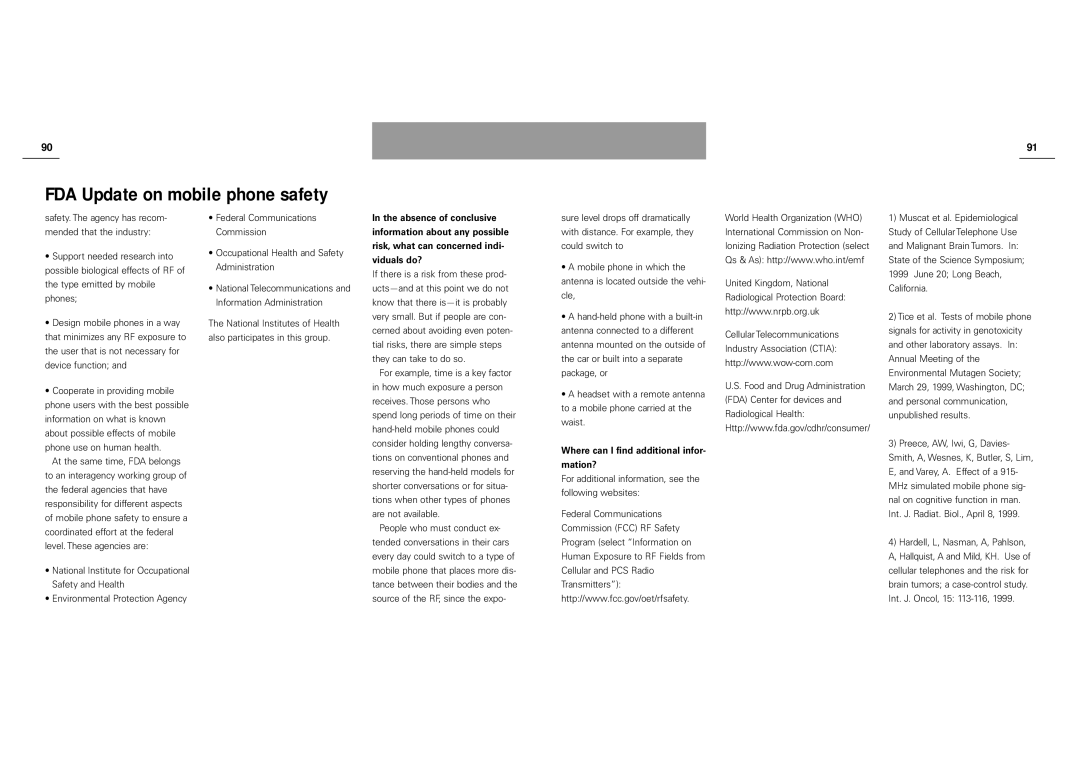
90
FDA Update on mobile phone safety
91
safety. The agency has recom- mended that the industry:
•Support needed research into possible biological effects of RF of the type emitted by mobile phones;
•Design mobile phones in a way that minimizes any RF exposure to the user that is not necessary for device function; and
•Cooperate in providing mobile phone users with the best possible information on what is known about possible effects of mobile phone use on human health.
At the same time, FDA belongs to an interagency working group of the federal agencies that have responsibility for different aspects of mobile phone safety to ensure a coordinated effort at the federal level. These agencies are:
•National Institute for Occupational Safety and Health
•Environmental Protection Agency
•Federal Communications Commission
•Occupational Health and Safety Administration
•National Telecommunications and Information Administration
The National Institutes of Health also participates in this group.
In the absence of conclusive
information about any possible
risk, what can concerned indi-
viduals do?
If there is a risk from these prod-
For example, time is a key factor in how much exposure a person receives. Those persons who spend long periods of time on their
People who must conduct ex- tended conversations in their cars every day could switch to a type of mobile phone that places more dis- tance between their bodies and the source of the RF, since the expo-
sure level drops off dramatically with distance. For example, they could switch to
•A mobile phone in which the antenna is located outside the vehi- cle,
•A
•A headset with a remote antenna to a mobile phone carried at the waist.
Where can I find additional infor-
mation?
For additional information, see the following websites:
Federal Communications Commission (FCC) RF Safety Program (select “Information on Human Exposure to RF Fields from Cellular and PCS Radio Transmitters”): http://www.fcc.gov/oet/rfsafety.
World Health Organization (WHO) International Commission on Non- Ionizing Radiation Protection (select Qs & As): http://www.who.int/emf
United Kingdom, National Radiological Protection Board: http://www.nrpb.org.uk
Cellular Telecommunications Industry Association (CTIA):
U.S. Food and Drug Administration (FDA) Center for devices and Radiological Health: Http://www.fda.gov/cdhr/consumer/
1)Muscat et al. Epidemiological Study of Cellular Telephone Use and Malignant Brain Tumors. In:
State of the Science Symposium; 1999 June 20; Long Beach, California.
2)Tice et al. Tests of mobile phone signals for activity in genotoxicity and other laboratory assays. In: Annual Meeting of the Environmental Mutagen Society; March 29, 1999, Washington, DC; and personal communication, unpublished results.
3)Preece, AW, Iwi, G, Davies- Smith, A, Wesnes, K, Butler, S, Lim, E, and Varey, A. Effect of a 915- MHz simulated mobile phone sig- nal on cognitive function in man. Int. J. Radiat. Biol., April 8, 1999.
4)Hardell, L, Nasman, A, Pahlson, A, Hallquist, A and Mild, KH. Use of cellular telephones and the risk for brain tumors; a
